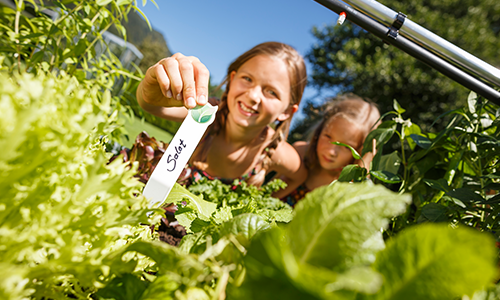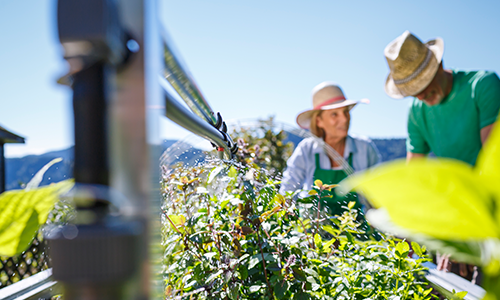Filling a raised bed correctly: tips and tricks
A raised bed is filled in layers . The natural rotting processes inside the raised bed provide the plants with nutrients and sufficient warmth - even during the cold season. Follow our tips for your raised bed and start the gardening season prepared.
Our raised beds
Let us not miss this opportunity to show our raised beds
With the right filling, our raised bed creates the ideal microclimate - so that your vegetables and herbs thrive even when the outside temperature is below freezing.Why is correct filling so important?
Soil temperature and nutrient content inside the raised bed depend directly on the composition of the soil corresponds to the natural conditions of the decomposition of plant parts. The correct filling therefore plays an important role in being able to effectively use the full potential of a raised bed . This means:
- Increased nutrient content
- Usability up to 10 months
- Earlier harvests
As the organic material inside the raised bed decomposes, sufficient natural nutrients are available that can be optimally absorbed by the plants. The natural decomposition process not only produces high-quality, nutrient-rich compost, but also heat . This heat makes it possible to cultivate the raised bed for up to 10 months a year, as there is no frost in the raised bed. With the right filling and a raised bed cover, it can also be used as a cold frame. The longer usability also means that plants can be planted earlier. This means that the first harvest of the year can be brought in earlier than with ground-level beds.
What preparations are necessary before filling?
A successful gardening season begins with the correct preparation of the raised bed. Before you start filling the raised bed properly, there are four important steps to consider.
- Location: Choosing the ideal location for your raised bed plays a crucial role. Choose a sunny location with good drainage to create optimal conditions for your plants.
- Remove weeds: Don't forget to thoroughly remove all weeds and grass . This will allow you to start with a clean bed and minimize annoying weed growth in the future. Don't forget to remove roots and stones too.
- Material: Choosing the right material makes the difference. A raised bed made of metal has many advantages. For example, it offers durability and stability . Compared to other materials, metal retains its shape and structure for years and despite bad weather conditions. It also offers protection against pests such as rodents and stores heat , which promotes healthy plant growth.
- Protection from animals: It is very important to consider how best to protect the raised bed protect from animals To protect your plants, you should secure the raised bed with a reliable grid or net This will prevent animals from entering the bed and causing damage.
Once this preparatory work is done, you can optimally fill and prepare the raised bed.
Step by step: filling the raised bed
Recommended filling
Step 1
Before you start filling, we recommend attaching a vole guard to the bottom of the raised bed. The first layer of filling is then placed directly on top of the vole guard : tree cuttings, shrub cuttings and/or hedge cuttings – the so-called “ wood core layer ”. This loose layer creates a loose structure, which means that the raised bed remains accessible to useful soil organisms. The combination with the mouse guard is ideal for keeping unwanted visitors away. The first layer is completed with approximately 5cm thick upturned turf for use.
Step 2
The bottom layer is followed by a second layer, about 20 cm thick, consisting of light Compost, leaf cuttings and grass clippings . When composting from your own garden, it is advisable to ensure that only plant waste is used for composting and not leftover meat or fish, in order not to attract vermin and avoid a strong smell. With a rapid composter, you can produce the highest quality compost in your garden, which is ideal for use anywhere in the garden.
Step 3
The top layer of a properly filled raised bed is a layer high-quality soil . You can either take soil from your garden (e.g. the soil that you removed in order to be able to set up the raised bed) or you can get organic black soil, for example . There is no need to add any extra compost to the layer of soil. The plants are then planted in this top layer of soil . If you follow this procedure when filling your raised bed, you can expect a bountiful, high-quality harvest for around 5 years.
What should I fill the raised bed with?
filling with garden waste
When filling the raised bed, ambitious gardeners follow the philosophy that their own garden already provides almost all the nutrients needed by the next generation of plants. But even for less experienced gardeners, composting and soil improvement is very easy to accomplish. In principle, you can use most natural garden waste in large quantities for filling. Only stubborn weed roots, such as those of dandelions or bindweed, should not be mixed in. By recycling garden waste, you need less or no fertilizer and still have high yields. Garden waste that can be used well is mainly:
- tree and hedge trimming
- shredded material
- grass clippings
- plant care waste
- bed cleaning after harvest
- leaves
filling with wood chips and compost
If you do not have enough garden waste available, or want to buy the individual components of the raised bed filling, then there is another option: filling the raised bed in 3 layers .
- Use various wood chips as the bottom layer . Fill a third of the raised bed with them.
- The second layer should ideally be made of naturally composted material Alternatively, horse or cow dung can be used.
- As a third layer, the raised bed is filled with high-quality soil.
Disadvantages:
Due to the lack of protection at the bottom, the risk of voles and other pests entering the raised bed increases considerably
The material used does not have the same high quality as organic material from your own garden.
Filling with straw bales or similar filling material
Part of the filling can also be replaced with straw bales or similar filling material.
- Start again by adding the bottom layer of wood chips .
- Now place a layer of straw or straw bales on the first layer
- The penultimate layer is – as in Alternative 1 – Cow dung or horse manure is used.
- You then conclude with a Layer of soil into which the plants are then planted.
Disadvantages:
Since the straw rots comparatively quickly, it will probably be necessary to refill the raised bed every year with this filling method.
filling with composted material
This method is a long-term and therefore requires a lot more time than the alternatives mentioned above. If you are in a hurry, you should opt for one of the approaches mentioned above.
- In this variant, the bottom layer of wood chips is created first.
- The raised bed will now be used as a composter for a year . Before plants or seeds are finally planted, a layer of topsoil and a layer of potting soil should be added on top of the composting material.
Disadvantages:
This variant takes a relatively long time and is therefore not suitable for spontaneous filling.
refill raised bed
- New material for the natural rotting processes
- Fresh nutrient supply
- Re-layer as the layers mix over time
- Use of the entire space in the raised bed
To refill the raised bed, the top layer of one half is usually raked to the side. Then you can easily fill it with grass clippings, compost or animal manure . Then you pull the soil back to its side and do the same with the other side. This means that the filling is back to its full height in spring, new nutrients become available and the new material from the lower part of the raised bed brings new rotting heat, which stimulates growth even better next year. This way you can continue to look forward to a rich harvest.




